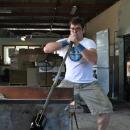Some things happen when you least expect it! In this case, it is Ben Edols and Kathy Elliot. We were still in New Zealand’s biggest city, Auckland, and hugely impressed from our visit to Gaffer, when their email dropped into our inbox. And so, we made our way directly to their place in Manly near Sydney.
Ben and Kathy have a giant Studio, with well set up hot and cold shops. Ben starts the pieces off at the furnace, and Kathy does the finishing touches. Working together in this way, they create some very interesting and wonderful products, which are also impressive due to their size. As Ben was short of help, we assisted him for one day at the furnace, and as a reward, we had a few hours the next day to make glass for ourselves.
Before we set foot on the Australian continent, we had a few colourful days in New Zealand. While marvelling at the intense colours of the landscape, we made our way from Wellington along the west coast to Auckland. A hot tip for anyone wishing to travel in Auckland: public transport is a nightmare. Franca and I wasted a lot of time searching around and waiting.
One really great thing, which we mentioned before, was Gaffer. They make colour glass tubes and are one of the three big producers in the world, the other two being the German companies, Kugler and Reichenbach. We got a friendly welcome, they were open and helpful, and we were given a detailed tour from John Croucher. We found it completely incredible that the colour rods are still predominantly made by hand. Two robots are busily working away, one together with a person produces the casting blocks, while the other one works with two people to produce the colour rods. This robot has been developed over the last three years and is now in the last stages of being fine-tuned, although a human can work nearly as fast.
The starting point for this company was a request from Ann Robinson, a well-known glass caster in New Zealand. She asked them if they could melt coloured glass tubing for her. After another job producing glass rods and being disappointed with the quality of Kugler Colors they started to produce the whole range for themselves. Their main criterion is the quality. They have been now been in production for twenty years and their main markets are America, England and Asia. They have developed their own formulas. One interesting extra piece of information is that the best quartz sand comes from Tasmania, as it has the lowest iron content worldwide. No photos exist of this amazing place, as they would like it to remain a secret from the German competition.
Some things happen when you least expect it! In this case, it is Ben Edols and Kathy Elliot. We were still in New Zealand’s biggest city, Auckland, and hugely impressed from our visit to Gaffer, when their email dropped into our inbox. And so, we made our way directly to their place in Manly near Sydney.
Ben and Kathy have a giant Studio, with well set up hot and cold shops. Ben starts the pieces off at the furnace, and Kathy does the finishing touches. Working together in this way, they create some very interesting and wonderful products, which are also impressive due to their size. As Ben was short of help, we assisted him for one day at the furnace, and as a reward, we had a few hours the next day to make glass for ourselves.
Before we set foot on the Australian continent, we had a few colourful days in New Zealand. While marvelling at the intense colours of the landscape, we made our way from Wellington along the west coast to Auckland. A hot tip for anyone wishing to travel in Auckland: public transport is a nightmare. Franca and I wasted a lot of time searching around and waiting.
One really great thing, which we mentioned before, was Gaffer. They make colour glass tubes and are one of the three big producers in the world, the other two being the German companies, Kugler and Reichenbach. We got a friendly welcome, they were open and helpful, and we were given a detailed tour from John Croucher. We found it completely incredible that the colour rods are still predominantly made by hand. Two robots are busily working away, one together with a person produces the casting blocks, while the other one works with two people to produce the colour rods. This robot has been developed over the last three years and is now in the last stages of being fine-tuned, although a human can work nearly as fast.
The starting point for this company was a request from Ann Robinson, a well-known glass caster in New Zealand. She asked them if they could melt coloured glass tubing for her. After another job producing glass rods and being disappointed with the quality of Kugler Colors they started to produce the whole range for themselves. Their main criterion is the quality. They have been now been in production for twenty years and their main markets are America, England and Asia. They have developed their own formulas. One interesting extra piece of information is that the best quartz sand comes from Tasmania, as it has the lowest iron content worldwide. No photos exist of this amazing place, as they would like it to remain a secret from the German competition.

